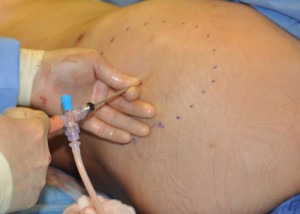The desire for a larger and more shapely buttocks has led to a surge in the number of buttock augmentation procedures performed today. While fat injections and implants make up the legitimate surgical methods to increase buttock size, there is a significant black market industry of buttock augmentation by a variety of unapproved injectable filler materials. The most commonly uses of these materials is silicone oil of various grades…none of them approved for human use for buttock augmentation.
Injecting silicone oils into subcutaneous tissues is known to potentially cause adverse tissue reactions and problems. These can include hard lumps, cellulitis and abscesses, pigmentation changes in the overlying skin and chronic pain. As a result the black market buttock injection industry has created numerous patients with chronic buttock problems….known as gluteal silicone toxicosis. This can be a very difficult problem to treat since removing the silicone material dispersed throughout the buttocks is impossible without wide excision and major buttock deformity.
In the March 2014 issue of Aesthetic Plastic Surgery, an article addressing the treatment of gluteal toxicosis appeared entitled ‘ Liposuction and Lipofilling for Treatment of Symptomatic Silicone Toxicosis of the Gluteal Region’. In this paper, liposuction was evaluated as a treatment method for this problem to maintain good buttock aesthetics and to limit the risk of complications. Eight patients (seven women and one man with an average age of 36 years old) ) were treated with combined liposuction and fat injections over a three year period. After one year after surgery, the patient’s pain levels were completely eliminated. No patients experienced any further infections or required ER visits or need for hospitalizations.

One approach that this study did not evaluate and can be considered for treating silicone buttock injection complications is what role does the liposuction play in its treatment. Since it can not remove all of the silicone and may only remove just a fraction of it, its purpose may be nothing more than to break up the scar tissue and granulomas and provide space for the injected fat. Thus, using the liposuction instruments for tunneling and not necessarily extraction may be just as effective and could result in a greater buttock size than before the treatment.
Dr. Barry Eppley
Indianapolis


